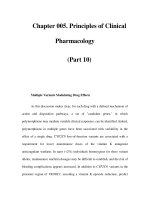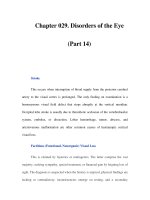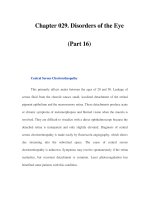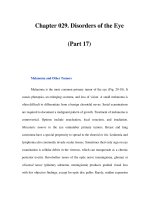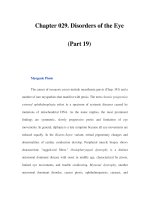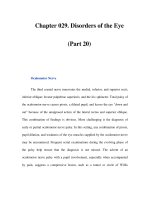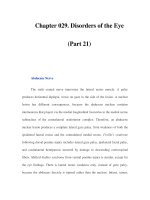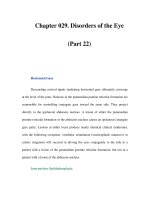Chapter 029. Disorders of the Eye (Part 10) potx
Bạn đang xem bản rút gọn của tài liệu. Xem và tải ngay bản đầy đủ của tài liệu tại đây (77.98 KB, 5 trang )
Chapter 029. Disorders of the Eye
(Part 10)
Central retinal artery occlusion combined with ischemic optic
neuropathy in a 19-year-old woman with an elevated titer of anticardiolipin
antibodies. Note the orange dot (rather than cherry red) corresponding to the fovea
and the spared patch of retina just temporal to the optic disc.
Figure 29-7
Hypertensive retinopathy with scattered flame (splinter) hemorrhages
and cotton-wool spots (nerve fiber layer infarcts) in a patient with headache and a
blood pressure of 234/120.
Impending branch or central retinal vein occlusion can produce prolonged
visual obscurations that resemble those described by patients with amaurosis
fugax. The veins appear engorged and phlebitic, with numerous retinal
hemorrhages (Fig. 29-8). In some patients, venous blood flow recovers
spontaneously, while others evolve a frank obstruction with extensive retinal
bleeding ("blood and thunder" appearance), infarction, and visual loss. Venous
occlusion of the retina is often idiopathic, but hypertension, diabetes, and
glaucoma are prominent risk factors. Polycythemia, thrombocythemia, or other
factors leading to an underlying hypercoagulable state should be corrected; aspirin
treatment may be beneficial.
Figure 29-8
Central retinal vein occlusion can produce massive retinal hemorrhage
("blood and thunder"), ischemia, and vision loss
Anterior Ischemic Optic Neuropathy (AION)
This is caused by insufficient blood flow through the posterior ciliary
arteries supplying the optic disc. It produces painless, monocular visual loss that is
usually sudden, although some patients have progressive worsening. The optic
disc appears swollen and surrounded by nerve fiber layer splinter hemorrhages
(Fig. 29-9). AION is divided into two forms: arteritic and nonarteritic. The
nonarteritic form of AION is most common. No specific cause can be identified,
although diabetes and hypertension are frequent risk factors. No treatment is
available. About 5% of patients, especially those over age 60, develop the arteritic
form of AION in conjunction with giant cell (temporal) arteritis (Chap. 319). It is
urgent to recognize arteritic AION so that high doses of glucocorticoids can be
instituted immediately to prevent blindness in the second eye. Symptoms of
polymyalgia rheumatica may be present; the sedimentation rate and C-reactive
protein level are usually elevated. In a patient with visual loss from suspected
arteritic AION, temporal artery biopsy is mandatory to confirm the diagnosis.
Glucocorticoids should be started immediately, without waiting for the biopsy to
be completed. The diagnosis of arteritic AION is difficult to sustain in the face of
a negative temporal artery biopsy, but such cases do occur rarely.
Figure 29-9
Anterior ischemic optic neuropathy from temporal arteritis in a 78-year-old
woman with pallid disc swelling, hemorrhage, visual loss, myalgia, and an
erythrocyte sedimentation rate of 86 mm/h
